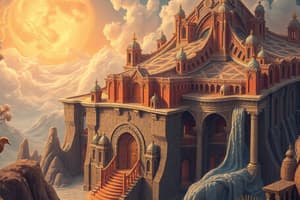Podcast
Questions and Answers
What is the term for the movement of molten rock beneath the Earth's surface?
What is the term for the movement of molten rock beneath the Earth's surface?
- Convection currents (correct)
- Magma
- Earth's structure
- Plate tectonics
What is the term for a mixture of water and magma that erupts explosively?
What is the term for a mixture of water and magma that erupts explosively?
Phreatomagmatic
The Pacific plate is one of the 6 continental plates.
The Pacific plate is one of the 6 continental plates.
False (B)
The process of moving tectonic plates is driven by _______________________ in the Earth's mantle.
The process of moving tectonic plates is driven by _______________________ in the Earth's mantle.
What is the term for a type of volcanic eruption that involves the gentle flow of lava?
What is the term for a type of volcanic eruption that involves the gentle flow of lava?
Match the following types of volcanoes with their characteristics:
Match the following types of volcanoes with their characteristics:
What is the term for a type of lava that is rich in silica and has a high viscosity?
What is the term for a type of lava that is rich in silica and has a high viscosity?
The Earth's core is divided into an inner core and an outer core.
The Earth's core is divided into an inner core and an outer core.
The movement of tectonic plates can cause _______________________ and volcanic eruptions.
The movement of tectonic plates can cause _______________________ and volcanic eruptions.
What is the term for the process of conserving water?
What is the term for the process of conserving water?
Study Notes
Physical Environment: Living with Natural Hazards
- Natural hazards are related to plate tectonics, magma, and convection currents in the Earth's mantle.
- The Earth's structure consists of an inner core, outer core, and mantle.
- There are 6 continental plates, including the Pacific plate, which plays a significant role in volcanic eruptions.
Volcanic Eruptions
- Volcanic eruptions can be classified into three types: active, dormant, and extinct.
- Eruptions can be further categorized into three types: phreatomagmatic, effusive, and explosive.
- Lava types include basaltic, rhyolitic, and andesitic.
- Plate boundaries can be convergent, divergent, or transitional.
- Products of volcanic eruptions include those erupted into the air (tephra and gas) and those erupted along the surface (lava and pyroclastic flow).
- Lahar refers to a type of mudflow or landslide that occurs when volcanic ash and debris mix with water.
Plate Tectonics
- Tectonic activity is responsible for earthquakes, volcanoes, and different types of plate movements.
- Plate movements can be convergent, divergent, or transitional, leading to earthquakes, volcanic activity, and the formation of landforms.
- Hotspots are areas of volcanic activity that occur at the boundary between tectonic plates.
Earthquakes
- Earthquakes can be predicted and prepared for, but their effects can be devastating.
- Case studies of earthquakes include Kobe, Japan; Mt Tarawera, New Zealand; Merapi, Indonesia; Mount St Helens, USA; and Afghanistan, 1998.
- Earthquake effects can be mitigated through disaster preparedness and response strategies.
Volcanic Eruptions and Earthquakes in Specific Regions
- Case studies of volcanic eruptions and earthquakes include Samoa, 2009; Haiti, 2010; Gisborne, 2007; Cyclone Ofa, Samoa, 1990; Cyclone Isaac, Tonga, 1982; Cyclone Heta, Samoa and Tonga, 2004; and Hurricane Katrina, USA, 2005.
- Each case study highlights the causes, effects, and strategies for mitigation and response.
Agricultural and Fishing
- Agricultural and fishing activities can be affected by natural hazards such as cyclones and hurricanes.
- Oil pollution, damage to infrastructure, and water pollution can have significant impacts on these industries.
Water
- Water is a renewable resource, but its distribution and availability vary greatly around the world.
- Factors affecting water supply include climate, geology, pollution, over-abstraction, limited infrastructure, poverty, and politics.
- Water conservation and rationing are essential strategies for managing water resources.
Water Cycle and River Basin
- The water cycle is crucial for understanding the distribution and availability of freshwater.
- River basins are an important feature of the water cycle, providing benefits such as irrigation, drinking water, and hydroelectric power.
- Case studies of river basins highlight the importance of managing these resources sustainably.
Studying That Suits You
Use AI to generate personalized quizzes and flashcards to suit your learning preferences.
Description
Test your knowledge of natural hazards, plate tectonics, and the Earth's structure. Learn about volcanic eruptions, types of lava, and plate boundaries.


